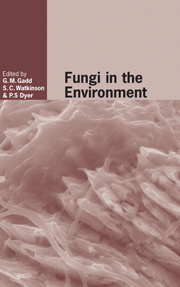Book contents
- Frontmatter
- Contents
- List of contributors
- Preface
- I Imaging and modelling of fungi in the environment
- II Functional ecology of saprotrophic fungi
- 5 Mineral transformations and biogeochemical cycles: a geomycological perspective
- 6 Mycelial responses in heterogeneous environments: parallels with macroorganisms
- 7 Natural abundance of 15N and 13C in saprotrophic fungi: what can they tell us?
- III Mutualistic interactions in the environment
- IV Pathogenic interactions in the environment
- V Environmental population genetics of fungi
- VI Molecular ecology of fungi in the environment
- Index
- References
6 - Mycelial responses in heterogeneous environments: parallels with macroorganisms
from II - Functional ecology of saprotrophic fungi
Published online by Cambridge University Press: 03 November 2009
- Frontmatter
- Contents
- List of contributors
- Preface
- I Imaging and modelling of fungi in the environment
- II Functional ecology of saprotrophic fungi
- 5 Mineral transformations and biogeochemical cycles: a geomycological perspective
- 6 Mycelial responses in heterogeneous environments: parallels with macroorganisms
- 7 Natural abundance of 15N and 13C in saprotrophic fungi: what can they tell us?
- III Mutualistic interactions in the environment
- IV Pathogenic interactions in the environment
- V Environmental population genetics of fungi
- VI Molecular ecology of fungi in the environment
- Index
- References
Summary
Introduction
Terrestrial fungi are commonly studied in the laboratory, growing on artificial media in which nutrients are typically homogeneously distributed and supplied in superabundance, the environment is sterile and microclimate (temperature, moisture, gaseous regime) usually relatively constant. This contrasts with the natural environment, in which: nutrients are often patchily and sparsely distributed or not readily available, because they are locked in recalcitrant material (e.g. lignin); many other organisms are encountered, including other fungi, bacteria and invertebrates; and microclimate is constantly changing, both temporally and spatially. This chapter explores the ways in which fungi cope with environmental heterogeneity. Similar situations are faced by macroorganisms and analogies are drawn. Emphasis is placed on basidiomycetes, not only because they have been studied in most detail, but because of their dominant role as decomposers and mutualistic symbionts (Boddy & Watkinson, 1995; Smith & Read, 1997) and because they are better adapted to respond to environmental heterogeneity over scales ranging from micrometres to many metres than are other fungi.
Both saprotrophic and ectomycorrhizal Basidiomycota form extensive mycelial systems in woodland soil and litter, but it is the former that are the focus of this review. Saprotrophic, cord-forming Basidiomycota that ramify at the soil–litter interface, interconnecting disparate litter components, provide most examples. The key feature of these fungi that fits them for growth in environments where resources are heterogeneously distributed is that they are non-resource-unit restricted, i.e. they can grow out of one resource in search of others.
- Type
- Chapter
- Information
- Fungi in the Environment , pp. 112 - 140Publisher: Cambridge University PressPrint publication year: 2007
References
- 16
- Cited by



